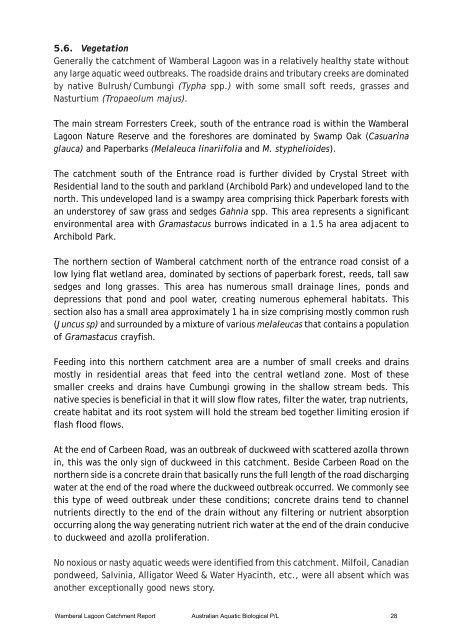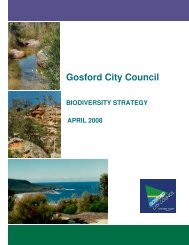Wamberal Lagoon Catchment Aquatic Survey Final Report (PDF ...
Wamberal Lagoon Catchment Aquatic Survey Final Report (PDF ...
Wamberal Lagoon Catchment Aquatic Survey Final Report (PDF ...
You also want an ePaper? Increase the reach of your titles
YUMPU automatically turns print PDFs into web optimized ePapers that Google loves.
5.6. Vegetation<br />
Generally the catchment of <strong>Wamberal</strong> <strong>Lagoon</strong> was in a relatively healthy state without<br />
any large aquatic weed outbreaks. The roadside drains and tributary creeks are dominated<br />
by native Bulrush/Cumbungi (Typha spp.) with some small soft reeds, grasses and<br />
Nasturtium (Tropaeolum majus).<br />
The main stream Forresters Creek, south of the entrance road is within the <strong>Wamberal</strong><br />
<strong>Lagoon</strong> Nature Reserve and the foreshores are dominated by Swamp Oak (Casuarina<br />
glauca) and Paperbarks (Melaleuca linariifolia and M. styphelioides).<br />
The catchment south of the Entrance road is further divided by Crystal Street with<br />
Residential land to the south and parkland (Archibold Park) and undeveloped land to the<br />
north. This undeveloped land is a swampy area comprising thick Paperbark forests with<br />
an understorey of saw grass and sedges Gahnia spp. This area represents a significant<br />
environmental area with Gramastacus burrows indicated in a 1.5 ha area adjacent to<br />
Archibold Park.<br />
The northern section of <strong>Wamberal</strong> catchment north of the entrance road consist of a<br />
low lying flat wetland area, dominated by sections of paperbark forest, reeds, tall saw<br />
sedges and long grasses. This area has numerous small drainage lines, ponds and<br />
depressions that pond and pool water, creating numerous ephemeral habitats. This<br />
section also has a small area approximately 1 ha in size comprising mostly common rush<br />
(Juncus sp) and surrounded by a mixture of various melaleucas that contains a population<br />
of Gramastacus crayfish.<br />
Feeding into this northern catchment area are a number of small creeks and drains<br />
mostly in residential areas that feed into the central wetland zone. Most of these<br />
smaller creeks and drains have Cumbungi growing in the shallow stream beds. This<br />
native species is beneficial in that it will slow flow rates, filter the water, trap nutrients,<br />
create habitat and its root system will hold the stream bed together limiting erosion if<br />
flash flood flows.<br />
At the end of Carbeen Road, was an outbreak of duckweed with scattered azolla thrown<br />
in, this was the only sign of duckweed in this catchment. Beside Carbeen Road on the<br />
northern side is a concrete drain that basically runs the full length of the road discharging<br />
water at the end of the road where the duckweed outbreak occurred. We commonly see<br />
this type of weed outbreak under these conditions; concrete drains tend to channel<br />
nutrients directly to the end of the drain without any filtering or nutrient absorption<br />
occurring along the way generating nutrient rich water at the end of the drain conducive<br />
to duckweed and azolla proliferation.<br />
No noxious or nasty aquatic weeds were identified from this catchment. Milfoil, Canadian<br />
pondweed, Salvinia, Alligator Weed & Water Hyacinth, etc., were all absent which was<br />
another exceptionally good news story.<br />
<strong>Wamberal</strong> <strong>Lagoon</strong> <strong>Catchment</strong> <strong>Report</strong> Australian <strong>Aquatic</strong> Biological P/L 28

















